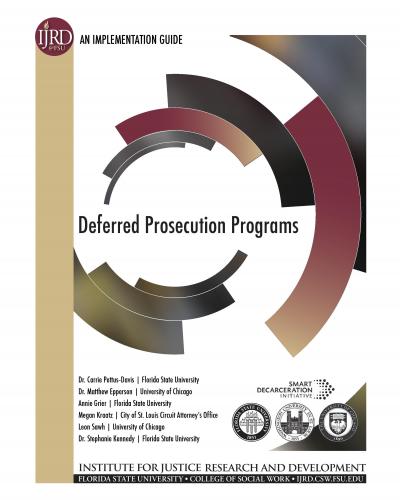
Deferred Prosecution Programs: An Implementation Guide
Published:
| Author: Carrie Pettus-Davis, Matthew Epperson, Annie Grier, Megan Kraatz, Leon Sawh, Stephanie Kennedy
Deferred prosecution is one prosecutor-led diversion mechanism that has the potential to reduce criminal justice involvement and incarceration rates while maximizing public safety.
Category: Smart Decarceration, Diversion, Deferred Prosecution

When Death Follows Release
Published:
| Author: Carrie Pettus-Davis, Stephanie Kennedy
This report highlights the reentry period - leaving incarceration and returning home - as the highest risk time for death in a formerly incarcerated individuals’ life. The purpose of this report is to explore the deaths that occur during the reentry period from several different vantage points.
Category: Reentry, Well-Being, 5-Key Model for Reentry
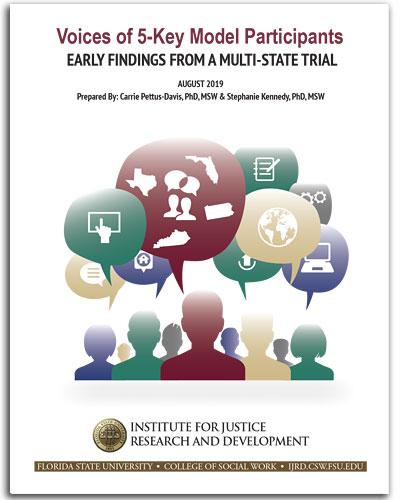
Voices of 5-Key Model Participants
Published:
| Author: Carrie Pettus-Davis, Stephanie Kennedy
This report contains interviews from four study participants involved in the 5-Key Model. The purpose of this report is to highlight the stories of participants in the 5-Key Model to provide a personal window into the experiences of those recently released from prisons. The interview explored participants’ lives and families, successes and challenges, and solicited advice for effectively helping individuals leaving incarceration.
Category: Reentry, Well-Being, 5-Key Model for Reentry

Intervention development study of the five-key model for reentry: An evidence-driven prisoner reentry intervention
Published:
| Author: Carrie Pettus-Davis, Tanya Renn, Christopher Veeh, Jacob Eikenberry
Over the past decade and a half, substantial resources were poured into the development of prisoner reentry programs. However, the excitement that surrounded the initial rollout of reentry programs has begun to wane from a lack of substantive change to the number of individuals who return to prison. Therefore, this article details the development of an intervention that can provide a new path forward for prisoner reentry programs.
Category: 5-Key Model for Reentry, Well-Being

Pathways to Recidivism for women released from prison:A Mediated model
Published:
| Author: Stephen Tripodi, Carrie Pettus-Davis, Kimberly Bender, Michael Fitzgerald, Tanya Renn, Stephanie Kennedy
Findings showed no direct relationship between childhood trauma and reincarceration for women in the sample, although there was a significant mediated relationship from childhood trauma to depression to reincarceration. Results suggest the importance of addressing incarcerated women’s trauma before release, assessing for depression, and using empirically-supported interventions to treat depression when applicable.
Category: Incarcerated Women, Reentry

Accelerating Science Using the Research-to-Practice Feedback Loop
Published:
| Author: Carrie Pettus-Davis, Stephanie Kennedy
The report details the implementation of a Research-to-Practice Feedback Loop and how this Feedback Loop has been used to overcome challenges and adapt both the 5-Key Model intervention and how the intervention is delivered to individuals as they release from prison. The Feedback Loop provides space for practitioners, study participants, and researchers to identify areas for improvement and formalizes a process to ensure that any changes made are consistent with the original model, acceptable to all parties, and implemented fairly across all study sites.
Category: Reentry, Well-Being, 5-Key Model for Reentry
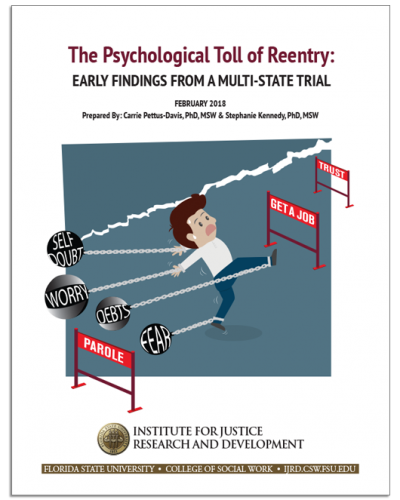
The Psychological Toll of Reentry
Published:
| Author: Carrie Pettus-Davis, Stephanie Kennedy
The struggle of reentry is common across hundreds of study participants and the reentry experience has a wide range of ripple out consequences for individual, family, and community well-being, and it intersects with the potential for future criminal behavior and public safety.
Category: Reentry, Well-Being, 5-Key Model for Reentry
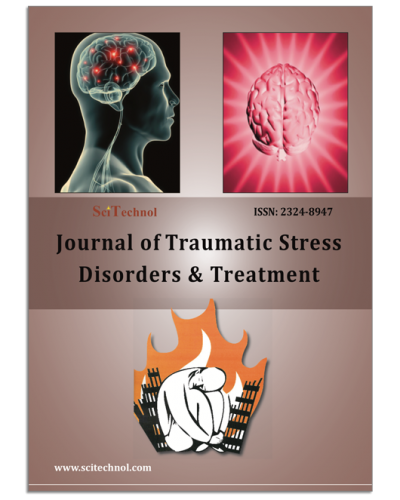
What Trauma Looks Like for Incarcerated Men: A Study of Men’s Lifetime Trauma Exposure in Two State Prisons
Published:
| Author: Maria Morrison, Carrie Pettus-Davis, Tanya Renn, Christopher Veeh, Christopher Weatherly
While it is understood that high rates of trauma exposure are common among incarcerated male populations, there is limited data on the nature of the trauma exposure. This study examined the trauma histories of a randomly selected sample of 67 men incarcerated in the Missouri Department of Corrections. The analyses revealed several patterns among study participants, including near universal trauma exposure in adolescence with the most frequent exposures involving witnessing or being proximate to violent deaths of family and friends.
Category: Trauma
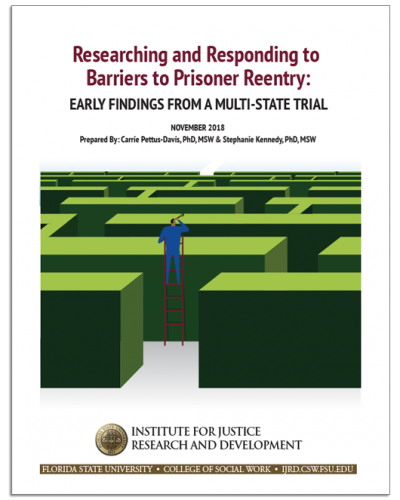
Researching and Responding to Barriers to Prisoner Reentry
Published:
| Author: Carrie Pettus-Davis, Stephanie Kennedy
This report describes the inner workings and early discoveries of participants and researchers in a groundbreaking longitudinal study currently occurring in four states, 50 prisons, 12 urban and rural counties with more than 1800 people enrolled since May 2018. The study, officially titled A Multisite Randomized Controlled Trial of the 5 Key Model for Reentry, is research that is occurring as a part of a larger initiative referred to as the Safe Streets and Second Chances initiative.
Category: Reentry, Well-Being, 5-Key Model for Reentry
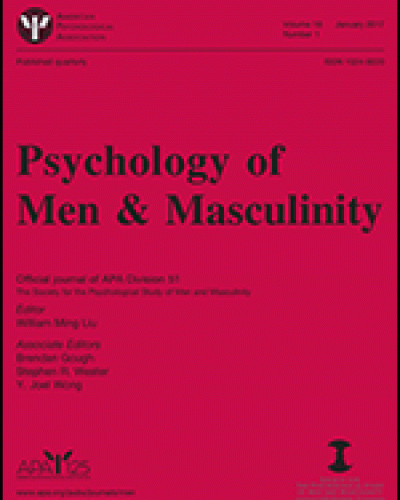
Proposing a population-specific intervention approach to treat trauma among men during and after incarceration.
Published:
| Author: Carrie Pettus-Davis, Tanya Renn, Jeffrey Lacasse, Robert Motley
A significant treatment gap exists for incarcerated men with lifetime traumatic experiences. A small research base for trauma interventions for incarcerated women is emerging, but incarcerated men have largely been ignored. Men comprise 90% of the incarcerated population and are at the greatest risk to be rearrested for a new crime after release.
Category: Trauma, In-Prison Intervention, Reentry

Promoting Reentry Well-Being: A Novel Assessment Tool for Individualized Service Assignment in Prisoner Reentry Programs
Published:
| Author: Christopher Veeh, Tanya Renn, Carrie Pettus-Davis
The Reentry Well-Being Assessment Tool (RWAT) is an innovative practice tool to systematically guide individualized assignment into reentry program services based on a participant’s changing needs during the transition from prison to the community. Clearly defined treatment targets that promote an individual’s well-being are paired with a comprehensive set of assessments within the RWAT to measure progress throughout a prisoner reentry program.
Category: Reentry, Well-Being

Incarcerated Women’s Experiences and Perceptions of Participating in Research
Published:
| Author: Lisa Schelbe, Amanda Hardwick, Ashley N. Wilfong, Cynthia E. Hanifin, Stephen Tripodi, Carrie Pettus-Davis
The research process within prisons has largely considered researchers’ perspectives. Only one known study explicitly examined incarcerated persons’ perceptions and no known studies have explored incarcerated persons’ experiences with research on sensitive topics. This study examines incarcerated women’s experiences with participating in research on victimization. A thematic analysis was conducted on responses to open-ended questions about participating in a research study from 227 women in two prisons who participated in a study about victimization.
Category: Incarcerated Women, Trauma
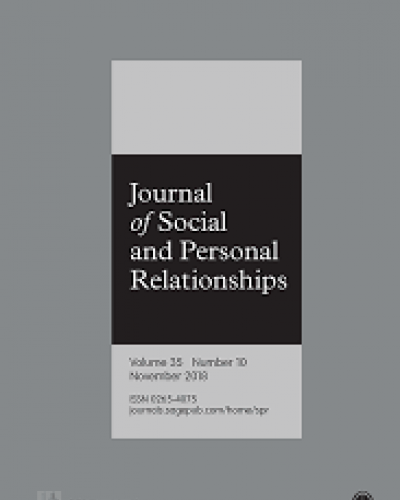
Gender differences in experiences of social support among men and women releasing from prison
Published:
| Author: Carrie Pettus-Davis, Christopher Veeh, Maxine Davis, Stephen Tripodi
Positive social support is critically important to postprison well-being outcomes. However, researchers and program developers are still trying to understand how to best promote stable and sustainable social support for formerly incarcerated individuals during reentry to the community. We sought to add to the body of knowledge on social support and prisoner reentry by comparing men and women releasing from prison on the quality (e.g., positive or negative) and amount of informal social support.
Category: Reentry, Incarcerated Women, Gender Differences
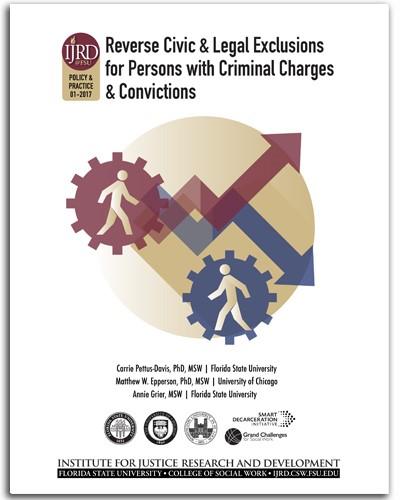
Reverse Civic and Legal Exclusions for Persons with Criminal Charges and Convictions
Published:
| Author: Carrie Pettus-Davis, Matthew Epperson, Annie Grier
Civil disability policies entangle persons with criminal convictions in a web of civic and legal bans that revoke or restrict their rights and limit access to services needed for an individual’s successful community reintegration. These policies—also known as collateral consequences—extend the reach of criminal justice punishment long after contact with the formal system has ended. There are now an estimated 40,000 civil disability policies nationwide—policies that affect the daily lives of individuals.
Category: Collateral Consequences of Incarceration, Smart Decarceration

REVERSE CIVIC AND LEGAL EXCLUSIONS FOR PERSONS WITH CRIMINAL CHARGES AND CONVICTIONS
Published:
| Author: Carrie Pettus-Davis, Matthew Epperson, Annie Grier
Civil disability policies entangle persons with criminal convictions in a web of civic and legal exclusions
that revoke or restrict their rights and limit access to services needed for an individual’s successful
community reintegration. These policies—also known as collateral consequences—extend the reach of
criminal justice punishment long after contact with the formal system has ended. There are now an
estimated 40,000 civil disability policies nationwide—policies that affect the daily lives of individuals,

